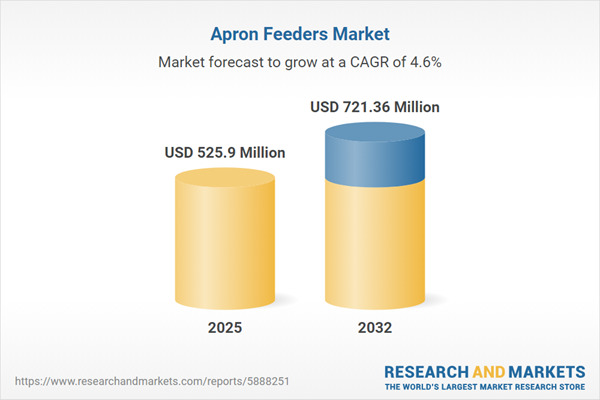Speak directly to the analyst to clarify any post sales queries you may have.
The apron feeders market is evolving rapidly as industrial organizations seek robust, high-efficiency material handling solutions to optimize durability, increase uptime, and ensure compliance with international standards. Executives recognize the strategic value in advanced feeder systems, driving investments that secure reliable operations in complex industry environments.
Apron Feeders Market Snapshot
The global apron feeders market is witnessing robust expansion, propelled by the widespread integration of automated feeder technologies within process-driven industries. Growth is particularly evident among mining, chemical processing, construction, and recycling sectors, as enterprises modernize feeder infrastructure for enhanced plant reliability and improved operational workflows. This modernization not only strengthens competitive positioning but also prompts a shift toward resource-efficient and integrated solution procurement. Decision-makers are increasingly aligning their capital allocations with broader organizational imperatives focused on process resilience, advanced material handling, and adapting to new compliance expectations. As a result, enterprises are better able to maintain operational continuity and respond nimbly to global market dynamics.
Scope & Segmentation of the Apron Feeders Market
- Product Types: Electromagnetic feeders provide gentle material transport for fragile inputs; hydraulic models offer flexible load management; mechanical designs serve high-intensity operational needs; vibratory systems ensure precise movement control. Each type supports adaptations for varied industrial requirements and site-specific demands.
- Applications: Apron feeders are integral for consistent material transfer and sustained throughput in mining, chemical production, food processing, metals manufacturing, construction, and recycling. Solutions help maintain process reliability and continuous compliance across the material flow chain.
- Capacities: High, medium, and low throughput variations meet the needs of both large-scale industrial operations and niche smaller sites, providing scalable support for evolving production priorities.
- Sales Channels: Procurement occurs through original equipment manufacturers and authorized distributors, who offer technical guidance spanning system design, installation, and ongoing operational maintenance for lasting reliability.
- Regions: Market momentum is significant in North America, South America, Europe, the Middle East & Africa, and Asia-Pacific. Infrastructure upgrades and industrial modernization initiatives in China, India, Japan, Australia, and Southeast Asia are intensifying uptake of next-generation feeder technologies.
- Leading Companies: Top manufacturers including Metso Outotec Corporation, FLSmidth & Co. A/S, and ThyssenKrupp Industrial Solutions AG drive innovation and deliver comprehensive compliance assistance and customer support across global markets.
Key Takeaways for Senior Decision-Makers
- Implementing next-generation apron feeder systems supports uninterrupted production and operational stability in high-output industrial environments.
- IoT-enabled diagnostics and real-time monitoring capabilities equip organizations with proactive maintenance and asset management tools, strengthening lifecycle outcomes.
- Engaging in technology partnerships and leveraging scalable designs gives businesses the flexibility to adapt to changing production targets or rapid capacity expansion strategies.
- Custom-engineered apron feeders are vital to ensuring alignment with diverse international regulations and addressing unique project site needs.
- Choosing suppliers with careful sourcing practices minimizes compliance risks and fosters consistent performance across complex, globalized supply chains.
Tariff Impact on Apron Feeders Market Economics
Recent shifts in United States tariff policy have increased acquisition costs, leading organizations to reevaluate sourcing models for apron feeders. Many executives now prioritize local partner networks, broaden their base of approved suppliers, and explore remanufactured system options to mitigate supply chain risk. These evolving approaches help maintain steady operations and buffer material flows from market volatility. Strategic reviews of compliance protocols and capital investment plans are recommended as tariff landscapes evolve.
Methodology & Data Sources
This analysis employs a scenario-driven methodology supported by direct engagement with original equipment manufacturers, distributors, and end-users. Findings are verified through technical audits and expert triangulation, giving procurement and executive teams reliable guidance for material handling system investments.
Why This Apron Feeders Market Report Matters
- Presents actionable segmentation and insights to improve procurement, risk management, and strategic planning for critical material handling infrastructure.
- Equips executives to anticipate and effectively address shifting regulatory and compliance requirements in multiple operating regions.
- Informs decisions on system modernization and resource allocation, supporting continuous operational performance as markets and standards evolve.
Conclusion
Continuous advancements in apron feeder technology and sourcing are setting new benchmarks in material handling efficiency for heavy industries. Organizations that prioritize adaptable and resilient solutions will be best positioned to navigate new business opportunities and meet emerging regulatory demands.
Additional Product Information:
- Purchase of this report includes 1 year online access with quarterly updates.
- This report can be updated on request. Please contact our Customer Experience team using the Ask a Question widget on our website.
Table of Contents
3. Executive Summary
4. Market Overview
7. Cumulative Impact of Artificial Intelligence 2025
Companies Mentioned
The companies profiled in this Apron Feeders market report include:- Metso Outotec Corporation
- FLSmidth & Co. A/S
- ThyssenKrupp Industrial Solutions AG
- Weir Group PLC
- Astec Industries, Inc.
- KPI-JCI, LLC
- Superior Industries International, Inc.
- McLanahan Corporation
- Haver & Boecker OHG
- Schenck Process Holding GmbH
Table Information
| Report Attribute | Details |
|---|---|
| No. of Pages | 183 |
| Published | October 2025 |
| Forecast Period | 2025 - 2032 |
| Estimated Market Value ( USD | $ 525.9 Million |
| Forecasted Market Value ( USD | $ 721.36 Million |
| Compound Annual Growth Rate | 4.6% |
| Regions Covered | Global |
| No. of Companies Mentioned | 11 |









